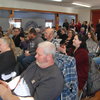Berne's year of departures and projects
Enterprise file photo — Marcello Iaia
Books on parade: Julianna Britton lugs a large box of books into the new home of the Berne library after she and other children paraded through the hamlet on Oct. 19. The library, now housed in the former St. Bernadette’s Catholic Church, has additional space for government workers and a large meeting room. It moved from a tighter space inside Town Hall, a former hotel and tavern.
A new gravestone was purchased this year for Harold C. Mattice, a corporal with the New York State Police, buried in Berne’s Woodlawn Cemetery. At the age of 33, he was the first Trooper to be killed by gunfire in the line of duty. Mattice was raised in Berne. The condition of his original, damaged marker was brought to the attention of The Enterprise by Fred Peter Bassler. Tom Mungeer, president of the New York State Trooper Police Benevolent Association, said the granite stone cost more than $1,000, and donations were made anonymously.
Enterprise file photo — Marcello Iaia
The long reach of controversial legislation: Republican Assemblyman Peter Lopez speaks to Hilltown residents in July inside the Berne-Knox-Westerlo auditorium during a meeting convened about the state’s latest gun-control law. The Secure Ammunition and Firearms Enforcement (SAFE) Act was passed in early January, and Berne passed a resolution, 4 to 1, in May condemning the swift passage of the law and calling for a meeting with state lawmakers. Representatives for the offices of State Senator Cecilia Tkaczyk and Assemblyman Angelo Santabarbara, both Democrats, attended on the officials’ behalf. Berne is not in Lopez’s district.
The Enterprise — Marcello Iaia
Defiant, decrepit structure: The building on the corner of routes 443 and 156 in the Berne hamlet has been considered a traffic hazard and now sits vacant as the calm, partially-frozen waters of Fox Creek flow by its hand-laid stone wall. The building is scheduled for demolition and an intersection improvement that would widen the east approach and replace the beams, deck, and railings of the nearby bridge, said Bryan Viggiani, spokesman for the state’s Department of Transportation. The area was damaged when the creek overflowed during Tropical Storm Irene in 2011. Supervisor Kevin Crosier said the wall across from the structure is going to be replaced, as well, in a separate project with state and federal funds.
BERNE — Two projects of large-scale cost, time, and community effort were completed in 2013, and at least two more are being planned for years to come.
The sewer project and the library were completed in the hamlet using large federal and state grants and loans, as well as community donations. For a new firehouse and intermunicipal training facility, a 25-acre parcel was purchased by the Berne Fire District on one of the town’s main thoroughfares.
One of the town’s most well-known officials, Patricia Favreau, retired at the end of the year after 34 years as the town’s clerk.
Training facility
The Berne Fire District purchased a piece of unused property on Route 443 this summer, once the site of an auto-repair business. The garage on the 25-acre parcel was repaired and will be used for storage, but ambitious plans for the land are expected to have an impact on East Berne.
A new firehouse for the East Berne Volunteer Fire Company is planned for the site, but it is several years from completion, according to Mary Alice Molgard, chairwoman of the Berne Fire District Board of Fire commissioners. The money would come from the district tax levy.
Like other fire departments, East Berne is cramped in its current firehouse with later trucks built with larger dimensions. The current firehouse has no ventilation, subjecting its meeting area to potential exhaust fumes. Extra space, a ventilation system, access for people with handicaps, and a new kitchen and meeting room would not be cost-effective to add on to the current firehouse, said Molgard.
The current East Berne firehouse sits above Route 443 on Main Street, less than a third of a mile away from the new property. One portion, with a garage modified to accommodate a taller door height, was built in 1962. Another portion, built in the mid-1980s, has the company’s meeting room above a second garage.
If the new property is used for an intermunicipal training center, people and commerce may come to the property from out of the town. The property is a short drive from the sheriff’s station in Clarksville. The Albany County Sheriff’s Office is seeking to use the land for equipment storage and a shooting range, and the Albany County Rural Fire Chiefs’ Association wants to build a training facility for its members to use for live fires.
Sheriff Craig Apple spoke about the proposed facility at the December town board meeting. He stressed that his office is committed to the project, which he believes would boost demand for local businesses.
Councilman Joseph Golden said he heard concerns about the shooting range, of its noise and potential effect on property values. Apple said he expects the shooting range would not be visible and that tree foliage would lessen the sound of gunfire.
“We’re not even in the infant stages yet,” Apple said of plans with the fire chiefs’ association.
Supervisor Kevin Crosier told The Enterprise that the sheriff’s office would be able to store its equipment, like snowmobiles, all-terrain vehicles, and surplus military equipment.
“That is huge, because, think about it, who needs it the most in a natural disaster? The Hilltowns,” said Crosier. “And now that stuff will be centrally located so that the entire Hilltowns can be centrally accessed.”
A classroom at the site could offer gun-, hunting-, and snowmobile-safety courses, Crosier said.
He knows of one resident in the area who has complained about the firing range; others neighboring the property are in favor of it, Crosier said, or “need more information.”
“We just don’t have enough data to present anything,” Crosier said of noise produced by the shooting range. “We have some preliminary tests we did, but very preliminary, with no mitigation at all.”
James Rissacher told The Enterprise that he was scared one morning in November when he heard shots being fired as he was working outside his home on Long Road. Rissacher said part of his parcel borders the fire district’s property. The fire district chief had called him, he said, and warned there would be sound tests.
“I didn’t know they were going to fire hundreds of rounds of ammunition,” said Rissacher.
Wastewater treatment
All summer long, the Berne hamlet saw dozens of men in bright vests in the road. A multi-million dollar wastewater collection system was installed along the streets, the culmination of almost 20 years of planning.
In 1984 and 1996, the Albany County Health Department conducted sanitary surveys in the hamlet that found properties there had failing septic systems. According to the 1996 survey, water samples showed 32 of 81 properties tested positive for E. coli, a bacterium found in intestines.
A major impetus for a municipal wastewater treatment system came when, in 2000, the state’s Department of Environmental Conservation issued a consent order requiring the town to stop effluent from draining into the Fox Creek.
At the end of February this year, the town board approved $2.6 million in bids for construction contracts. The total cost for the system was projected to be $3.6 million, about two-thirds of which is to come from grant funds. A 30-year, no-interest loan from the Environmental Facilities Corporation and DEC totals $1.18 million.
Crosier said at the December town board meeting that the sanitary collection system is 95-percent complete, and the treatment facility being built off the road leading to the Berne-Knox-Westerlo track is about 80-percent complete. The whole project is expected to be finished in April.
New library
Longer than its wait for the sewer project, the town has been awaiting a new location for its library. The former St. Bernadette’s Church became the new home of Berne’s books and educational programs in October, when children paraded their books from the old library in Town Hall to the new one across from the school.
“We had teens that would come in and they’d sit on the floor between the aisles,” said Judy Petrosillo, the library’s director, of the cramped former location.
The Berne Free Library was chartered in 1962, tucked into a modest dry-goods store on Route 443, about a mile from its current building. Books were donated from the community, and Berne residents built the shelves, donated the wood, and helped with its electrical work.
For the library’s latest move, Petrosillo and library board President Mary Kinnaird said, community members helped to sand and varnish much of the furniture bought second-hand from libraries and bookstores.
“That’s what’s so great about living in the Hilltowns, people have such a community-minded spirit,” said Kinnaird, who is stepping down after 10 years on the board. Kinnaird’s mother was also a longtime trustee.
Kinnaird said about 20 locations were considered over decades as leaders sought a more spacious library.
Crosier has said that, by subdividing the property and selling the parsonage that was purchased with the parcel with the church, he expects the town to have no more debt on the project. The parsonage would be sold after the sewer system is operating, he said.
Crosier reported at the December town board meeting that the costs for the new library were a third of a percent over their original projections.
“Let’s see if we can do that well on the new town hall,” said Crosier. Berne may renovate its current town hall, formerly a hotel, now that the library has left vacant space.
Resignation
In 2011, Bonnie Conklin became the first enrolled Republican elected to the town board since 1989. She voted mostly with the other four board members, but was a voice of dissent on several issues.
Conklin surprised board members with her resignation in November, citing her duties at work and discomfort with her role on the board.
“I think my discouragement is just my personality,” she said in November. She said she had been frustrated and stressed at town board meetings, knowing the other four board members disagreed with her.
Conklin’s most prominent point of disagreement with the board was in its resolution about the state’s gun-control law. She had support during a meeting at Town Hall where more than 80 people stood in the small board room to speak about the Secure Ammunition and Firearms Enforcement (SAFE) Act.
When it came time for the board to form its resolution addressing the state’s gun-control legislation, Conklin felt her draft wasn’t considered.
Board members responded through The Enterprise that Conklin submitted her resolution but hadn’t convinced a majority.
The town board now has just four members, all Democrats, and will likely appoint a new member to fill Conklin’s seat before the next election.
Clerk ends career with the town
Patricia Favreau ended her 34th year this December to retire.
As an active member of the New York State Town Clerks’ Association, and once its president, Favreau accumulated accolades and a reputation as an authority on the position, though, she said, she enjoys reading about the law.
If she had a question, she might check the town clerk’s manual that she helped to edit.
Favreau grew up in Eagle Bridge and moved to Berne with her mother and brother when she was 7 years old. They lived in the hotel that was her office space.
Her husband, John Favreau, was a teacher at Berne-Knox-Westerlo and sometimes helped in Town Hall as a deputy clerk.
A Democrat, Favreau won her first term in 1980, when the position was part-time and she also worked as a waitress.
She used to be the town’s election officer, a role she was proud of.
“It felt like my duty as a town clerk,” said Favreau.



